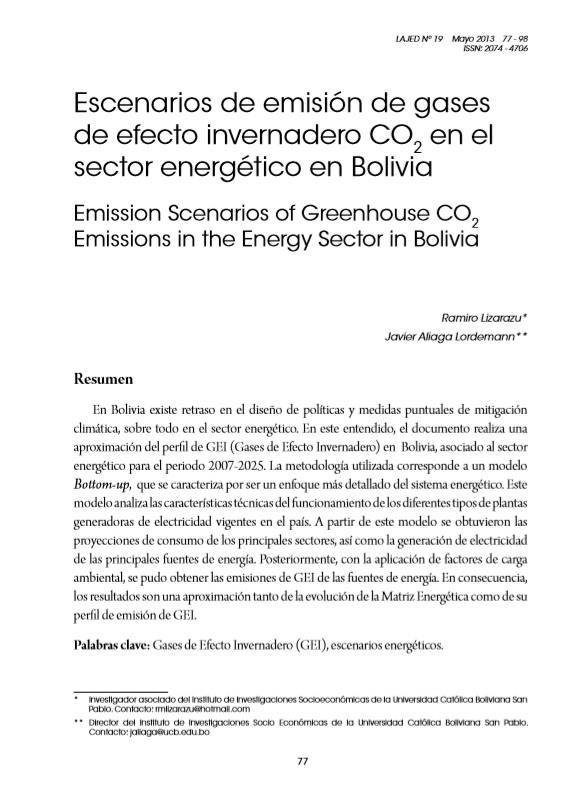Emission Scenarios of Greenhouse CO2 Emissions in the Energy Sector in Bolivia
DOI:
https://doi.org/10.35319/lajed.201319109Keywords:
Greenhouse Gas (GHG), Energy ScenariosAbstract
In Bolivia there is a lag in the design of specific policies and climate mitigation, especially in the energy sector. In this manner, the paper presents an approach profile of GHG (greenhouse gas) in Bolivia, linked to the energy sector for the period 2007-2025. The methodology used corresponds to a Bottom-up model, characterized for a detail scope of the energy system; it analyzes the technical characteristics of the operation of the various types of existing power plants in the country. With this model was obtained projections of consumption of major sectors, such as electricity generation of the main sources of energy. Later, with the implementation of environmental load factors, the GHG emissions from energy sources were obtained. Consequently, the results are an approximation of both, the evolution of the energy matrix and its GHG emission profile.
Downloads
References
Aliaga, J. y Leguía, D. (2011). Análisis municipal de los determinantes de la deforestación en Bolivia. Facultad de ciencias económicas y empresariales. Universidad de Zaragoza, España
---------- (2011). Deforestación en Bolivia. Una aproximación espacial. Mayo de 2011, Nº 15, 7-44
Aliaga, J. y Rubín de Celis, R. (2011). Ciclos económicos e inversión en Bolivia. Documento de trabajo 2/2011, IISEC- UCB.
Clarke, L.E.; Calvin, K.V.; Edmonds, J.A.; Kyle, G.P.; Kim, S.H.; Placet, M.; Smith, S.J. y Wise, M.A. (2008). CO2 Emissions Mitigation and Technological Advance: An Updated Analysis of Advanced Technology Scenarios (Scenarios Updated January 2009). Washington. Pacific Northwest National Laboratory.
Climate Change Task Force (ASME) (2009). Technology and policy recommendations and goals for Reducing carbon Dioxide emissions in the energy sector. Washington DC.
Edmunds, J.; Ntoumanis, N. y Duda, J.L. (2007). Adherence and well-being in overweight and close patients referred to an exercise on prescription scheme. A selfdetermination theory perspective. Psychology of Sport and Exercise, 8, 722-740.
Fundación Vida Silvestre Argentina (2006). Reducir emisiones ahorrando energía: escenarios energéticos para la Argentina (2006-2020) con políticas de eficiencia (1a ed.). Buenos Aires.
Intergovernmental Panel on Climate Change (IPCC) (1996). Technologies, Policies and Measures for Mitigating Climate Change. Technical Paper.
Ministerio de Medio Ambiente y Agua (2009). Inventario de emisiones de gases de efecto invernadero de Bolivia, 2002-2004. La Paz: Digital S.RL.
Organización de las Naciones Unidas para el Desarrollo Industrial (ONUDI) (2011). Informe sobre el desarrollo industrial 2011. Eficiencia energética industrial para la creación sostenible de riqueza. Viena, Austria.
Somoza Cabrera, José (2006). Modelos para la estimación y proyección de la demanda de electricidad en el sector residencial cubano. Ensayo para la obtención de los créditos correspondientes a la suficiencia investigativa. Tesis de doctorado. Programa de Doctorado Universidad de Oviedo-Universidad de La Habana. Cuba.






